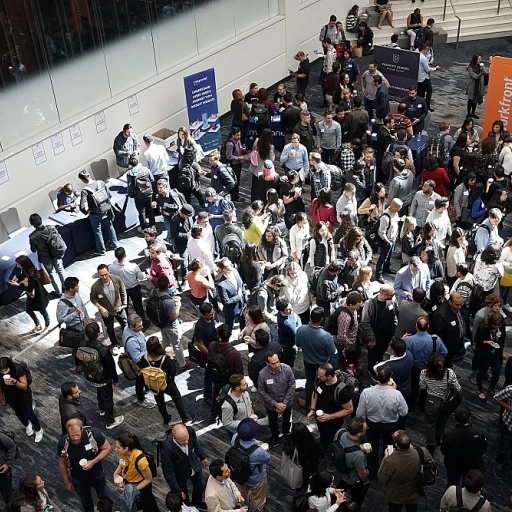Understanding the CHRO's Role in Workforce Planning
The Evolving Landscape of Workforce Planning
In the ever-changing business world, the Chief Human Resources Officer (CHRO) plays a crucial role in workforce planning. This function involves more than simply recruiting and managing talent; it's a strategic element that contributes significantly to long-term business success. As businesses pivot to meet new challenges, the CHRO's responsibility in shaping and aligning the workforce with organizational goals cannot be overstated.Aligning HR Strategies with Business Objectives
A core aspect of the CHRO's role in workforce planning is ensuring that HR strategies are aligned with the overarching objectives of the company. This alignment involves a deep understanding of the business’s current and future needs, facilitating a proactive approach to talent acquisition and management. By collaborating with other key stakeholders, the CHRO ensures that the workforce is not only prepared for present tasks but is also equipped to handle future challenges. This strategic alignment underscores the role of the CHRO as a business partner, rather than just an administrative leader.Anticipating and Responding to Change
Workforce planning under the guidance of the CHRO must be adaptable to the changes in the business environment. Whether it’s advancements in technology or shifts in market demand, the CHRO needs to anticipate these changes and prepare the workforce accordingly. This agility not only helps the organization stay competitive but also enhances the resilience of the workforce, allowing for smoother transitions and continuity in operations.Fostering a Positive Company Culture
Another integral aspect of the CHRO's role in workforce planning is fostering a company culture that supports strategic objectives. Understanding how culture influences employee performance and engagement is paramount for achieving success. The CHRO must champion initiatives that promote a healthy and inclusive work environment, thus creating a workforce that is motivated and aligned with the company’s vision. For more insights on how the CHRO shapes company culture, check out this resource. Overall, the CHRO's role in workforce planning is pivotal for building a robust, flexible, and dynamic workforce. By effectively managing this function, CHROs not only contribute to immediate organizational goals but also pave the way for sustainable business growth in the future."}Strategic Workforce Planning: A Key to Business Success
Aligning Business Objectives with Workforce Needs
Strategic workforce planning is an essential element that enables organizations to successfully align their business objectives with the ever-evolving demands of the workforce. As businesses navigate through constant changes in technology, market dynamics, and talent availability, the role of the Chief Human Resources Officer (CHRO) becomes pivotal in steering this alignment. With their deep understanding of organizational goals and human capital, CHROs are uniquely positioned to bridge the gap between executive aspirations and workforce capabilities. By crafting a strategic workforce plan, CHROs ensure that the right talent is in place to meet current and future business demands, thereby paving the way for sustainable success.Integrating Technological Advancements
The rapid pace of technological advancements has significantly influenced how businesses operate and evolve. To keep up with these changes, CHROs must be proactive in integrating technology into workforce planning processes. This integration not only enhances efficiency but also provides insights through data-driven decision-making. For example, people analytics play a crucial role in predicting future workforce trends and identifying skill gaps, enabling organizations to prepare proactively rather than reactively. Moreover, leveraging technology in workforce planning allows CHROs to optimize processes, refine talent acquisition strategies, and enhance overall employee experience. This forward-thinking approach supports businesses in maintaining a competitive edge in an ever-changing landscape. To learn more about how to master talent acquisition strategies as a CHRO, explore this comprehensive guide.Facilitating Agile Workforce Strategies
In today's dynamic business environment, agility is more critical than ever. CHROs must champion agile workforce strategies to keep pace with ongoing changes and market demands. By adopting a flexible approach, businesses can rapidly adjust their workforce structures, thus enhancing their ability to capitalize on new opportunities and tackle unexpected challenges. Through strategic workforce planning, CHROs play a vital role in fostering an adaptable organizational culture. This involves not only developing frameworks that allow for agility but also actively engaging with leadership teams to promote a mindset of continuous improvement and innovation. Ultimately, an agile workforce strategy supports long-term business resilience and growth, ensuring that organizations are well-prepared for future uncertainties.Talent Management and Employee Engagement
Fostering a Thriving Workforce
In strategic workforce planning, the CHRO must be adept at nurturing talent management and ensuring robust employee engagement. It's an integral part of the broader strategy, aiming to align the workforce with the company’s business objectives. This alignment not only supports company goals but also fortifies a sustainable future for both the business and its employees. Talent management begins with identifying the skills and roles critical for the company's success. By understanding these needs, the CHRO can develop and implement programs that attract, develop, and retain top talent. This includes creating career advancement paths, offering continuous learning opportunities, and providing a supportive work environment. Moreover, employee engagement is a critical lever in talent management. Ensuring that employees are motivated and committed requires a genuine understanding of their needs, aspirations, and pain points. By fostering strong organizational culture and clear communication, the CHRO can enhance job satisfaction and, in turn, improve productivity and retention. A strategic approach to engagement doesn’t stop at motivation – it also involves acknowledging accomplishments and providing feedback. Recognizing employees' contributions and encouraging transparent communication cultivates a sense of belonging and purpose. Ultimately, successful talent management and employee engagement hinge on the CHRO's ability to leverage people analytics. As companies continue to navigate an ever-evolving business climate, the CHRO's role in driving talent management and employee engagement becomes increasingly indispensable. By effectively managing these components, organizations can maintain a competitive edge and ensure a workforce ready to meet future challenges.Leveraging People Analytics for Better Decision Making
{ "result": "Harnessing the Power of People Analytics
In the transformative journey of workforce planning, one of the most potent tools at the disposal of a Chief Human Resources Officer (CHRO) is people analytics. As businesses navigate through the challenges of aligning talent management with strategic goals, data-driven insights become vital in making informed decisions that drive business success.
People analytics leverages data to analyze workplace patterns and trends, offering a comprehensive view of the workforce landscape. For CHROs, this means they can not only foresee potential talent gaps but can also proactively address them before they impact the business. The value of these insights is immense, contributing to more robust strategic workforce planning (referenced in earlier discussions) by providing a clear picture of the current and future needs of the organization.
Real-Time Insights for Proactive Decision Making
With the fast-paced evolution of the business environment, the ability to access real-time data and analytics is crucial. People analytics enables CHROs to monitor employee performance, engagement, and turnover trends, thereby empowering them to make proactive decisions. These insights also allow the human resources team to tailor their strategies, ensuring they are fostering a work environment that promotes both productivity and satisfaction.
Driving Efficient Talent Acquisition and Management
By utilizing people analytics, CHROs can also refine their talent acquisition and management processes. Data-driven strategies can lead to more accurate hiring decisions, aligning potential candidates’ skillsets with business needs. Furthermore, understanding employee engagement levels through analytics helps in crafting strategies that retain top talent and nurture the workforce, aligning closely with the goals of talent management and employee engagement previously discussed.
Building a Diverse and Inclusive Workforce
Another significant advantage of people analytics lies in promoting diversity, equity, and inclusion within the workforce. Through detailed analysis, organizations can identify and address diversity gaps, ensuring a balanced and inclusive workplace. CHROs, by capitalizing on these insights, can foster an environment where varied perspectives are valued, leading to innovative solutions and driving the business towards future success.
" }







